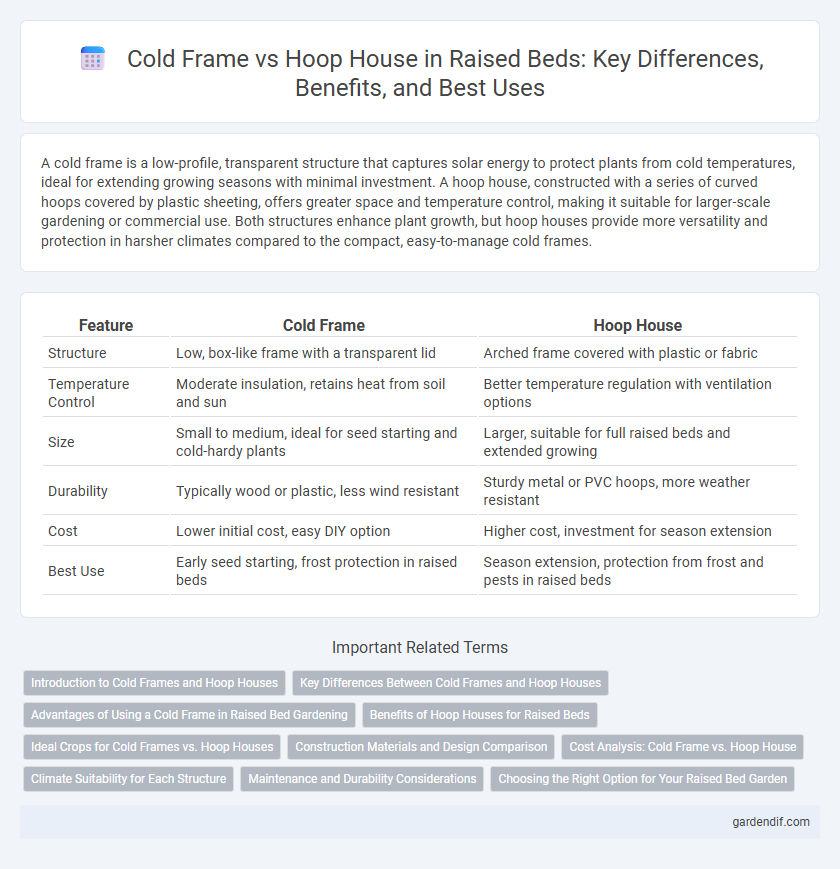
Cold frame vs Hoop house Illustration
A cold frame is a low-profile, transparent structure that captures solar energy to protect plants from cold temperatures, ideal for extending growing seasons with minimal investment. A hoop house, constructed with a series of curved hoops covered by plastic sheeting, offers greater space and temperature control, making it suitable for larger-scale gardening or commercial use. Both structures enhance plant growth, but hoop houses provide more versatility and protection in harsher climates compared to the compact, easy-to-manage cold frames.
Table of Comparison
| Feature | Cold Frame | Hoop House |
|---|---|---|
| Structure | Low, box-like frame with a transparent lid | Arched frame covered with plastic or fabric |
| Temperature Control | Moderate insulation, retains heat from soil and sun | Better temperature regulation with ventilation options |
| Size | Small to medium, ideal for seed starting and cold-hardy plants | Larger, suitable for full raised beds and extended growing |
| Durability | Typically wood or plastic, less wind resistant | Sturdy metal or PVC hoops, more weather resistant |
| Cost | Lower initial cost, easy DIY option | Higher cost, investment for season extension |
| Best Use | Early seed starting, frost protection in raised beds | Season extension, protection from frost and pests in raised beds |
Introduction to Cold Frames and Hoop Houses
Cold frames and hoop houses are essential structures for extending the growing season in raised beds by protecting plants from harsh weather conditions. Cold frames are low, transparent-roofed boxes that trap solar heat, ideal for hardening off seedlings and growing cool-season crops. Hoop houses, made with curved metal or PVC frames covered by plastic, provide larger, warmer environments suitable for frost protection and early planting.
Key Differences Between Cold Frames and Hoop Houses
Cold frames provide a low-profile, insulated environment ideal for protecting seedlings and extending the growing season with minimal structure. Hoop houses offer larger, tunnel-shaped covers that create a warmer microclimate suitable for full-season crop production and greater space for plant growth. The key differences lie in size, temperature control, and versatility, with cold frames being more compact and efficient for early season use, while hoop houses accommodate a broader range of plants and longer growing periods.
Advantages of Using a Cold Frame in Raised Bed Gardening
Cold frames in raised bed gardening offer enhanced temperature control by trapping solar heat, extending the growing season for tender plants. Their solid structure provides superior protection against wind, pests, and frost compared to hoop houses. Cold frames require less maintenance and are more cost-effective, making them ideal for gardeners seeking a durable, low-effort option for early seed starting and overwintering crops.
Benefits of Hoop Houses for Raised Beds
Hoop houses offer extended growing seasons for raised beds by providing superior temperature control and frost protection compared to cold frames. Their flexible design allows for improved ventilation, reducing humidity and preventing mold growth while maximizing sunlight exposure. This adaptability enhances plant growth and yield, making hoop houses a valuable investment for raised bed gardening.
Ideal Crops for Cold Frames vs. Hoop Houses
Cold frames are ideal for growing leafy greens, herbs, and seedlings that require moderate protection and cooler temperatures, extending the growing season in early spring and late fall. Hoop houses suit a wider range of crops, including tomatoes, peppers, cucumbers, and other warm-season vegetables that benefit from higher temperatures and more space for vertical growth. Both structures enhance crop yield by providing controlled environments but differ in temperature tolerance and crop variety suitability.
Construction Materials and Design Comparison
Cold frames typically feature a wooden or metal frame with a transparent glass or polycarbonate lid designed to trap heat and protect plants from frost. Hoop houses consist of flexible PVC or metal hoops covered with polyethylene plastic, creating a lightweight, tunnel-like structure that extends growing seasons. Both structures utilize materials selected for durability and insulation, but cold frames offer a more compact, rigid design while hoop houses provide larger, more flexible growing spaces.
Cost Analysis: Cold Frame vs. Hoop House
Cold frames typically cost between $50 and $200 depending on size and materials, offering an affordable solution for small-scale gardening with simple construction. Hoop houses, on the other hand, range from $300 to over $1,000, reflecting their larger size and more durable materials suited for extended growing seasons. While initial investment in hoop houses is higher, their versatility and capacity often justify the cost for commercial or serious gardeners.
Climate Suitability for Each Structure
Cold frames excel in temperate climates by providing frost protection and extending the growing season through passive solar heating. Hoop houses are ideal for variable or colder climates, offering greater insulation and flexibility with controlled ventilation to maintain optimal temperature and humidity. Both structures enhance plant growth but differ significantly in climate adaptability and year-round usability.
Maintenance and Durability Considerations
Cold frames typically require less maintenance due to their simpler structure but may need seasonal rebuilding or repairs to wooden components affected by moisture and pests. Hoop houses, constructed with flexible PVC or metal frames and plastic covers, offer greater durability against weather extremes yet demand regular inspection and tightening of cover materials to prevent damage from wind and snow loads. Material quality and regional climate heavily influence the longevity and upkeep frequency of both cold frames and hoop houses in raised bed gardening.
Choosing the Right Option for Your Raised Bed Garden
Cold frames provide a compact, insulated environment ideal for extending the growing season in raised bed gardens by trapping solar heat and protecting plants from frost. Hoop houses offer a larger, versatile structure that shields from wind, pests, and extreme weather, enabling year-round cultivation with more space for tall or sprawling crops. Selecting between a cold frame and hoop house depends on your garden's size, climate, and the specific crops you want to grow in your raised bed.
Cold frame vs Hoop house Infographic

 gardendif.com
gardendif.com